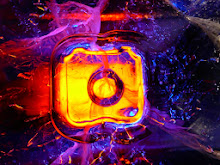The ancient barophagus that went extinct in the Tertiary period is believed to be the ancestor of the TM. The original name for TM in Tibet was "Do-Khyi". A lot has been written of the breed since 1121 B.C.; this is when a Chinese manuscript was dated telling of a Tibetan delegation giving as a symbol of friendship "a big dog" to the Emperor of China at the time, Wou-Wang. Marco Polo later described the TM as "a dog in the size of a donkey", "a cross-breed with tiger, fierce and wild", (the cattle in the area of northern China and Tibet was a lot smaller in size than modern cattle). It was mentioned as an unmutable and unconditional guard, prepared to kill every trespasser, man or animal. They were even used for hunting yak, bear and deer.There were mainly two different kinds of TM to protect the cattle and to help the village people: "bhotia"/"do-khyi", a lighter herding dog, and "tsang-khyi", watchdog in the yards. Bhotia wasn't a herding dog as we know sheepdogs today: it defended shepherds and cattle against wild animals and robbers. Tsang-khyi has been the guardian of monasteries and villages over the centuries. The most beautiful individuals of the tsang-khyi were called sang-khyi and were owned by persons in the highest positions in Tibet. This kind of dogs were sought after and a high status symbol. The two types mentioned above are also the ones that are mostly breeded in the west today: in the USA usually the larger tsang-khyi and in Europe the lighter do-khyi (bhotia). There has originally existed no less than five types of TM: dzi-khyi, naj-khyi, tsang-khyi, do-khyi and sgo-khyi. The breed came at a very early stage down to India, where it became shorter-haired - (this is likely to happen even today as modern representants of the breed are taken to warmer countries), and it travelled on from India further to Assyria. Skulls of dogs have been discovered in Persia and Syria dating from the Stone and Bronze Age, apparently belonging to the same family with the modern TM. It is difficult to find quite pure-breeded TM in Tibet, Nepal and the Himalaya area today; however, they are still used as watchdogs and sometimes as guardians of a caravan against wolves and robbers.Herodotos tells in early scripts of a large amount of Indian dogs kept in Babylon. The Romans and even the Greek used the TM on their military expeditions reaching as far west as Europe. These dogs "took part" even in the battle, and fought on the Roman arenas against bears, lions and gladiators.
Sunday, February 1, 2009
Subscribe to:
Post Comments (Atom)


No comments:
Post a Comment